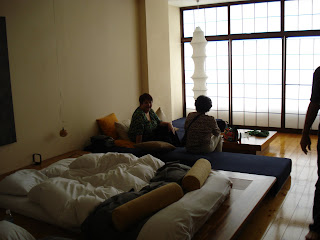The movie, though dramatic with a good story, turned out to be pretty violent. And it was all about Okinawa, but set during World War II, right after the Pearl Harbor attack. The war scenes had a lot of bloodshed and there were plenty of violent close-ups. What made me feel ok about the movie was the story, and how it depicted the American soldiers and Japanese soldiers. It didn't come off as biased because, though it did show lots of bombing, shooting and killing coming from the American side, it also showed the cruelty and mercilessness of Japanese commanders. One scene in particular I thought was telling: after showing bombings and firings from American tanks on villages in Okinawa, the following scene showed a Japanese commander shoot one of his own men because he refused to kill a wounded American they came upon in the jungle.
The reason I bring this is up is because I think telling this history is a real sensitive topic, and if it's going to be taught in Japanese schools it should be done with care. There were a few times when I was sitting in that room where the movie was being shown, genuinely hoping for a more or less unbiased account of what happened, lest my country be given a bad name because the film was taken out of historical context, or I get loads of stare downs from the students when the film finished. It was at one of these moments I remember thinking back to when Elizabeth and I visited the 'Peace Museum' in Nagasaki. The first exhibit there shows footage of the atomic bomb being dropped on Nagasaki (in slow motion, on several different screens) and I remember hearing a small Japanese boy say to his dad, while looking at this big mushroom cloud, 'America warui' (America is bad). And after recently reading a biography on the Japanese emperor at this time, Hirohito, and learning about all the wicked things that he and some Japanese leaders had done leading up to the war, I wanted to scream 'Look kid, you don't understand!' He was only about 5, so I let it go.
Though I disagree with showing a film with so much violence to these junior high kids (it would be classified as a drama but would have to be rated R given the scenes depicting violence), I think the film was balanced and empathetic. I couldn't understand a lot, it being all in Japanese, but I really think if there were some overtly racist or otherwise scenes I would have caught on. That kind of bend didn't fit this director's style.
Another reason I bring up this film is because I recently saw a public presentation of history that went beyond violence and promoted nationalistic, racist views. While in Seoul, Elizabeth and I went to a place called 'Seodaemun Prison.' This place was built around 1912 and run by Japan during its occupation of Korea (1910-45). When we walked down to check out the cell holding area, we immediately heard recorded screams being repeated and smelled a musty funk that made me light-headed. Inside the cells were manikins of Korean victims and Japanese guards, showing multiple still-lives of water torture, sexual torture and beatings. There was a lot of fake blood used in the displays and one of the Korean manikin women had her shirt torn open in the front. All the while endless recorded screams and a stale odor permeated the air. Being there was almost like hanging out in a nightmare.
Opting to leave rather than see the rest, we forewent the footage and photos of prison life they also had on display. On the ticket stubs we received they read 'A living education site for Korean history where visitors can pay a high tribute to the patriotic ancestors who valiantly fought against the Japanese invasion for sovereign independence, and renew the determination of the spirit of independence.' This is the thesis and narrative of the site. Elizabeth pointed this out - Does it make sense to talk about 'the colonizers' as if they are, monolithically, the same groups of people that existed in the first half of the 20th century and now? We both agreed that if you were a kid and went and visited that place (and to our disappointment we saw middle school aged girls and parents with kids that looked about 7) you could easily grow up hating the Japanese. And this is not to downplay the brutality of the Japanese occupation, but just to point out the Japanese today, though descendants, are a different generation than they were 60+ years ago, as were the Koreans, and should be treated as such. Let's just say, at Seodaemun Prison, the torture chambers had way more nuance than the introductory signs.
I think part of what made the Peace Museum in Nagasaki so well done was how it showed some aspects of 'gruesomeness' without going overboard with it. That's also why I think the Holocaust museum in D.C. is well done, because you get a sense of the awful experience of the Holocaust without having to, in a sense, experience it yourself. The film shown today and the prison site in Seoul are both historical expressions in public places. I think those kids I sat with today would have been better off with a film that didn't use so much gore to make a point, and the displays at that prison site in Seoul are not only too distasteful to be put on public display but also promote a dangerous mix of nationalism and racism.
 The entrance to Seodaemun Prison.
The entrance to Seodaemun Prison.



